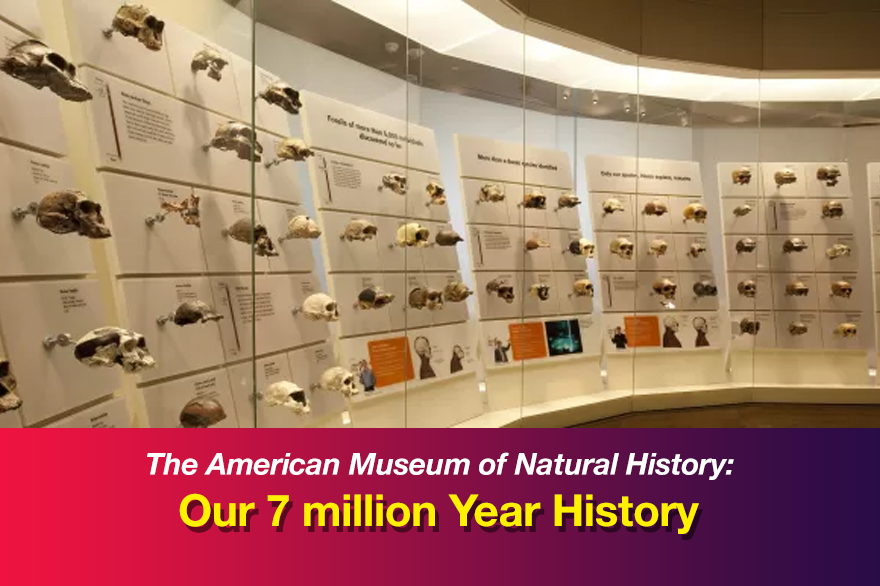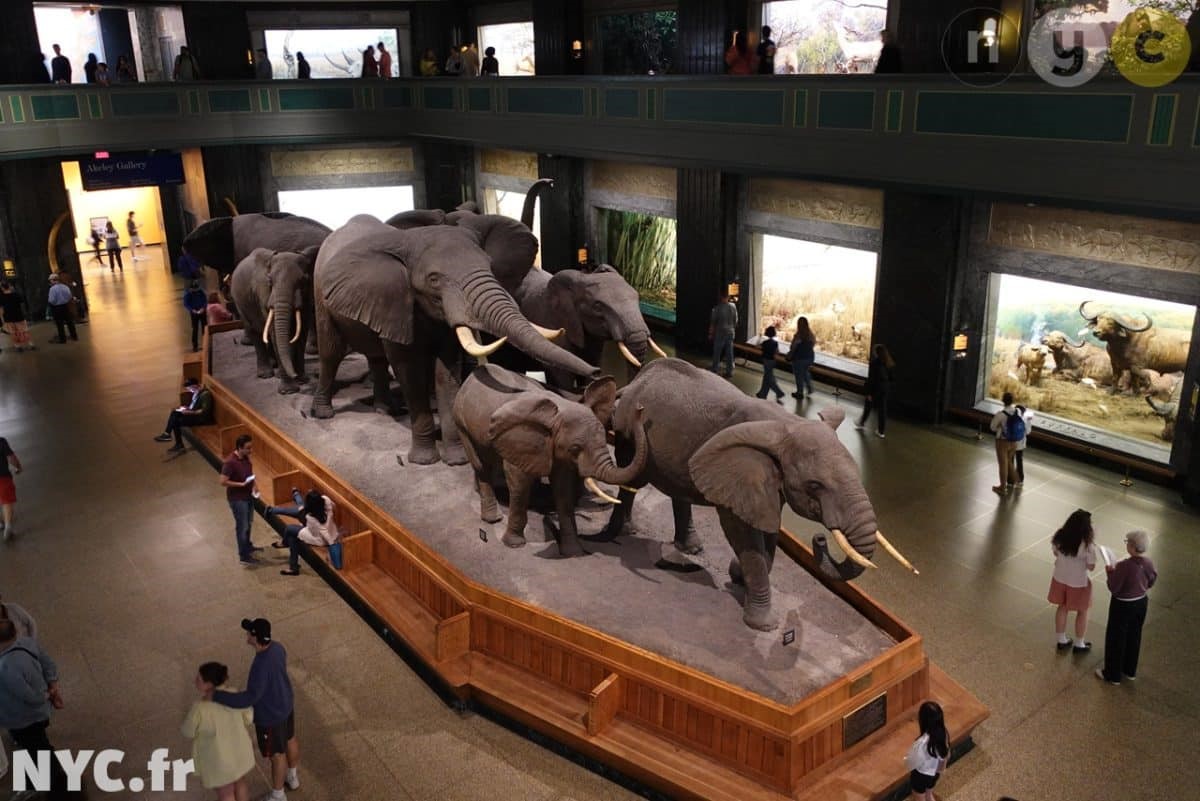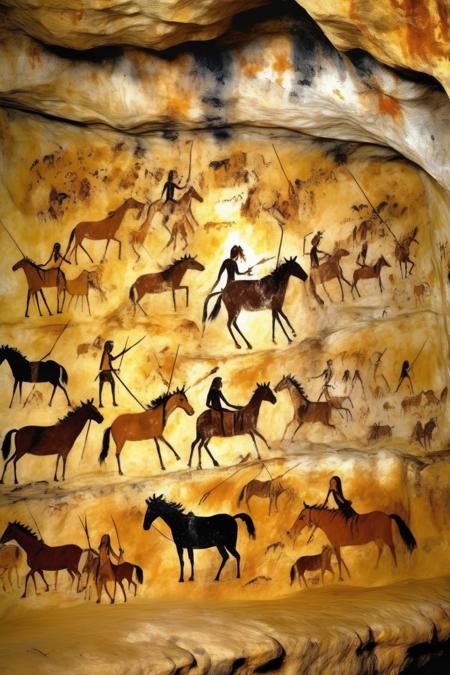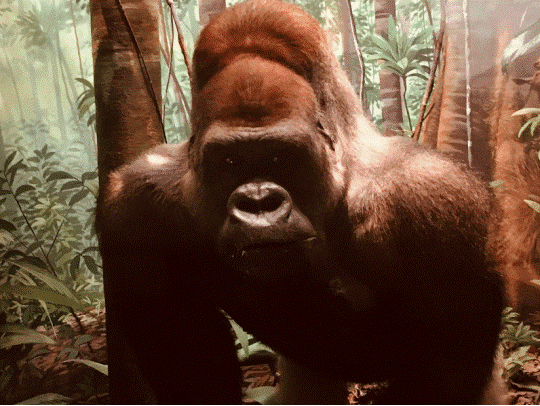The American Museum of Natural History: Our 7 million Year History
April 15, 2025

American Museum of Natural History
There was one more major museum that I wanted to explore before I left New York City. The American Museum of Natural History is a complex of 21 buildings housing 45 permanent exhibition halls in addition to a planetarium and a library. The museum collections contain about 32 million specimens of plants, animals, fungi, fossils, minerals, rocks, meteorites, human remains, and human cultural artifacts. The museum occupies more than 2,500, 000 square feet and averages about 5 million visits a year.

This museum has 4 full stories. I decided to start at the top and work my way down. The top floor had massive full-size dinosaur and mammal skeletons.
 As I worked through each floor, each the size of several football fields, I was amazed by the actual size of these animals as well as the huge variety.
As I worked through each floor, each the size of several football fields, I was amazed by the actual size of these animals as well as the huge variety.
Before I knew it, I began to get hungry – it was lunch time. That called for a trip to the Ground Floor and the Food Court where I recharged. Then I was ready for the First Floor and the Hall I was most looking forward to.
 When I was in high school, I saw an issue of National Geographic magazine that has haunted me ever since. Louis Leakey and his wife Mary after literally decades of searching found a skull that dated over 3 million years ago. The skull was significant because it documented the first distinction between our human ancestors and all other species that went before us. The skull had small canine teeth. That doesn’t sound like much until you compare our canine teeth to a chimpanzee whose canines are terrifyingly massive.
When I was in high school, I saw an issue of National Geographic magazine that has haunted me ever since. Louis Leakey and his wife Mary after literally decades of searching found a skull that dated over 3 million years ago. The skull was significant because it documented the first distinction between our human ancestors and all other species that went before us. The skull had small canine teeth. That doesn’t sound like much until you compare our canine teeth to a chimpanzee whose canines are terrifyingly massive.
Millions of Year Old Footprints
A few years later Mary Leakey discovered footprints that were literally millions of years old. Apparently two of our ancestors walked through damp volcanic ash. The ash hardened and preserved this priceless evidence. The footsteps proved the second major distinction between ourself and any other line of creatures. The footsteps proved our ancestors were bipedal, which meant they walked very much like we walk today. These footsteps were over 3 million years old.

About 10 years later Donald Johanson, PhD discovered a reasonably complete skeleton of a human ancestor they nicked named “Lucy.” Lucy also had small canine teeth and her skeleton was complete enough that it was clear she walked bipedally.
 A few years later, very primitive stone tools which were 2-3 million years old were discovered. Combined with a massive climate change that took place about this time, we began to get a clearer picture of how our distant ancestors lived on the savannahs of Eastern Africa. They were opportunistic scavengers. They stole raw meat from carcasses that had been temporarily deserted by a predator. Our ancestors used crude stone tools to hack off chunks of raw meat and smash the bones to get at the nutritionally rich bone marrow. We rushed away and huddled in the relative safety of a cave to eat our raw meat and high fat marrow. This was our way of life for hundreds of thousands of years
A few years later, very primitive stone tools which were 2-3 million years old were discovered. Combined with a massive climate change that took place about this time, we began to get a clearer picture of how our distant ancestors lived on the savannahs of Eastern Africa. They were opportunistic scavengers. They stole raw meat from carcasses that had been temporarily deserted by a predator. Our ancestors used crude stone tools to hack off chunks of raw meat and smash the bones to get at the nutritionally rich bone marrow. We rushed away and huddled in the relative safety of a cave to eat our raw meat and high fat marrow. This was our way of life for hundreds of thousands of years
 What changed this was our ancestor’s mastery of fire. Fire that we could control had all sorts of benefits. Warmth for one, and an effective protection from predators eating us. But the greatest benefit our ancestors derived from cooked meat was world class brain food. Eating cooked meat gave our ancestors 3 to 4 times more nutrition than eating raw meat. Meat and animal fat were already the most nutritious food our ancestors could eat. But cooking made this incredibly nutritious food source several times easier to assimilate. Cooked meat and fat are not only incredibly nutritious, but is easily digested within in 24 hours.
What changed this was our ancestor’s mastery of fire. Fire that we could control had all sorts of benefits. Warmth for one, and an effective protection from predators eating us. But the greatest benefit our ancestors derived from cooked meat was world class brain food. Eating cooked meat gave our ancestors 3 to 4 times more nutrition than eating raw meat. Meat and animal fat were already the most nutritious food our ancestors could eat. But cooking made this incredibly nutritious food source several times easier to assimilate. Cooked meat and fat are not only incredibly nutritious, but is easily digested within in 24 hours.
As doctor Richard Wrangham explains in his book Catching Fire, cooking meat made us human. This concept is in harmony with one of the most quoted papers in science: The Expensive Tissue Hypothesis. Why didn’t gorillas ever become as smart as us? It is very simple. An organism only has so much energy. Gorillas eat a vegetarian diet which has very little nutritional value. A gorilla must eat an enormous amount of food every day. Ever notice a gorilla’s huge belly? It takes a gorilla a week to 10 days to process this massive amount of highly fibrous (gorillas eat bamboo like it’s celery) low nutritionally dense food. It takes an incredible of energy and time to digest what a gorilla eats. So a gorilla’s life is fundamentally eating and sleeping.

Our ancestors lived a similar life until we began to eat animal protein and animal fat is which incredibly nutritionally and energy dense and nourishing, and our body digests cooked animal protein and animal fat in less than 24 hours. So, our gut began to shrink. And guess what began to grow. Our brain. When our ancestors switched from a gorilla-type diet to a predominately meat and fat diet, over the next several hundred thousand years, our brain and our intelligence grew 300%. And the skulls prove it.
As you can see in the banner photograph at the top of this newsletter this is called “the wall of skulls.” At the start of the wall our brain size and I.Q, were about the same as a chimp. 200,000 years ago, we were Homo Sapiens with big, smart brains. By 30 thousand years ago, we were making technically advanced tools and painting sophisticated and highly emotive cave paintings.
Importance of Protein
Your JDD morning shakes are incredibly nutritious and growth promoting for you and your family. The average height of a human being on a rice diet is 5 feet 2 inches. The average height of a male on an animal protein and animal fat diet is 6 feet 2 inches tall. The plains Indians, the so-called Bison People as all they ate was bison, had an average height of 6 feet 5 inches. Magnificent people.
JDD Shakes
Your shakes combined with Super Omega 3 fish oil capsules are amazing for your brain. I do 8 to 12 Super Omega 3 fish oil capsules every day without fail along with my 2 JDD shakes and plenty of whole eggs. Pure water combined with high quality animal food and full body aerobic exercise like walking with Heavy Hands supports your body thriving. I am 80 and still work out vigorously for at least an hour 6 days a week either Heavy Hands or rucking a very hilly course with a heavy pack. Reminds me of my days in the infantry in the Marine Corps.
As always, I wish you and your family tremendous health and energy. And be sure to feed your big, amazing brain.
Joe
 Cart (0)
Cart (0)

